Flood Modeling of the June 2023 Flooding of Léogâne City by the Overflow of the Rouyonne River in Haiti
Abstract
1. Introduction
2. Materials and Methods
2.1. Study Area
2.2. Data Acquisition
2.3. Discharge Estimation
2.4. Hydraulic Model and Simulation Tool
2.5. Summary of Data Used in This Study
3. Results
3.1. Rating Curve for the Rouyonne River
3.2. Rainfall–Discharge Relationship
3.3. Hydraulic Modeling of the 3 June 2023 Flood Hydrograph
4. Discussion
5. Conclusions
Author Contributions
Funding
Data Availability Statement
Acknowledgments
Conflicts of Interest
References
- Lhomme, J. Modélisation des Inondations en Milieu Urbain: Approches Unidimensionnelle, Bidimensionnelle et Macroscopique. Ph.D. Thesis, Université de Montpellier II, Sciences et Techniques du Languedoc, Montpellier, France, December 2006. [Google Scholar]
- Mathieu, G. Développement d’une Méthodologie Pour la Cartographie du Risque D’inondation: Application à la Rivière de Cavaillon en Haïti. Ph.D. Thesis, Université Catholique de Louvain, Ottignies-Louvain-la-Neuve, Belgium, January 2023. [Google Scholar]
- Joseph, A.; Gonomy, N.; Zech, Y.; Soares-Frazão, S. Modelling and analysis of the flood risk at Cavaillon City, Haiti. Houille Blanche 2018, 104, 68–75. [Google Scholar] [CrossRef]
- Crispino, G.; Gisonni, C.; Iervolino, M. Flood hazard assessment: Comparison of 1D and 2D hydraulic models. Int. J. River Basin Manag. 2015, 13, 153–166. [Google Scholar] [CrossRef]
- Horritt, M.S.; Bates, P.D. Evaluation of 1D and 2D numerical models for predicting river flood inundation. J. Hydrol. 2002, 268, 87–99. [Google Scholar] [CrossRef]
- Lhomme, J.; Soares-Frazão, S.; Guinot, V.; Zech, Y. Large scale modelling of urban floods and 2D shallow-water model with porosity. Houille Blanche 2007, 93, 104–110. [Google Scholar] [CrossRef]
- Van Emelen, S.; Soares Frazao, S.; Riahi-Nezhad, C.; Chaudhry, M.H.; Imran, J.; Zech, Y. Simulations of the New Orleans 17th Street Canal breach flood. J. Hydraul. Res. 2012, 50, 70–81. [Google Scholar] [CrossRef]
- Pinos, J.; Timbe, L. Performance assessment of two-dimensional hydraulic models for generation of flood inundation maps in mountain river basins. Water Sci. Eng. 2019, 12, 11–18. [Google Scholar] [CrossRef]
- Apel, H.; Aronica, G.T.; Kreibich, H.; Thieken, A. Flood risk analyses—How detailed do we need to be? Nat. Hazards 2009, 49, 79–98. [Google Scholar] [CrossRef]
- Dewals, B.J.; Detrembleur, S.; Archambeau, P.; Erpicum, S.; Ernst, J.; Pirotton, M. Caractérisation micro-echelle du risque d’inondation: Modélisation hydraulique détaillée et quantification des impacts socio-économiques. Houille Blanche 2011, 97, 28–34. [Google Scholar] [CrossRef][Green Version]
- Hrachowitz, M.; Savenije, H.H.G.; Blöschl, G.; McDonnell, J.J.; Sivapalan, M.; Pomeroy, J.W.; Arheimer, B.; Blume, T.; Clark, M.P.; Ehret, U.; et al. A decade of Predictions in Ungauged Basins (PUB)—A review. Hydrol. Sci. J. 2013, 58, 1198–1255. [Google Scholar] [CrossRef]
- Blöschl, G.; Bierkens, M.F.P.; Chambel, A.; Cudennec, C.; Destouni, G.; Fiori, A.; Kirchner, J.W.; McDonnell, J.J.; Savenije, H.H.; Sivapalan, M.; et al. Twenty-three Unsolved Problems in Hydrology (UPH)—A Community Perspective. Hydrol. Sci. J. 2019, 64, 1141–1158. [Google Scholar] [CrossRef]
- Buwalda, F.J.L.; De Goede, E.; Knepflé, M.; Vuik, C. Comparison of an Explicit and Implicit Time Integration Method on GPUs for Shallow Water Flows on Structured Grids. Water 2023, 15, 1165. [Google Scholar] [CrossRef]
- Mitsopoulos, G.; Panagiotatou, E.; Sant, V.; Baltas, E.; Diakakis, M.; Lekkas, E.; Stamou, A. Optimizing the Performance of Coupled 1D/2D Hydrodynamic Models for Early Warning of Flash Floods. Water 2022, 14, 2356. [Google Scholar] [CrossRef]
- Guo, W.; Zhai, M.; Lei, X.; Huang, H.; Long, Y.; Li, S. Two-Dimensional Hydrodynamic Simulation of the Effect of Stormwater Inlet Blockage on Urban Waterlogging. Water 2024, 16, 2029. [Google Scholar] [CrossRef]
- Martínez-Aranda, S.; Meurice, R.; Soares-Frazão, S.; García-Navarro, P. Comparative Analysis of HLLC- and Roe-Based Models for the Simulation of a Dam-Break Flow in an Erodible Channel with a 90° Bend. Water 2021, 13, 1840. [Google Scholar] [CrossRef]
- Guan, M.; Guo, K.; Yan, H.; Wright, N. Bottom-up multilevel flood hazard mapping by integrated inundation modelling in data scarce cities. J. Hydrol. 2023, 617, 129114. [Google Scholar] [CrossRef]
- Yang, Q.; Ma, Z.; Zhang, S. Urban Pluvial Flood Modeling by Coupling Raster-Based Two-Dimensional Hydrodynamic Model and SWMM. Water 2022, 14, 1760. [Google Scholar] [CrossRef]
- Delis, A.I.; Nikolos, I.K. Shallow Water Equations in Hydraulics: Modeling, Numerics and Applications. Water 2021, 13, 3598. [Google Scholar] [CrossRef]
- Soares-Frazão, S.; Zech, Y. HLLC scheme with novel wave-speed estimators appropriate for two-dimensional shallow-water flow on erodible bed. Int. J. Numer. Methods Fluids 2010, 66, 1019–1036. [Google Scholar] [CrossRef]
- Meurice, R.; Soares-Frazão, S. A 2D HLL-based weakly coupled model for transient flows on mobile beds. J. Hydroinform. 2020, 22, 1351–1369. [Google Scholar] [CrossRef]
- Sandra, S.F.; Yves, Z. Dam break in channels with 90 degrees bend. J. Hydraul. Eng. 2002, 128, 956–968. [Google Scholar]
- Soares-Frazao, S.; Zech, Y. Dam-break flow through an idealized city. J. Hydraul. Res. 2008, 46, 648–658. [Google Scholar] [CrossRef]
- Westerberg, I.K.; Sikorska-Senoner, A.E.; Viviroli, D.; Vis, M.; Seibert, J. Hydrological model calibration with uncertain discharge data. Hydrol. Sci. J. 2020, 67, 2441–2456. [Google Scholar] [CrossRef]
- Lee, M.; Yoo, Y.; Joo, H.; Kim, K.T.; Kim, H.S.; Kim, S. Construction of rating curve at high water level considering rainfall effect in a tidal river. J. Hydrol. 2021, 37, 100907. [Google Scholar] [CrossRef]
- Jafarzadegan, K.; Moradkhani, H. Regionalization of stage-discharge rating curves for hydrodynamic modeling in ungauged basins. J. Hydrol. 2020, 589, 125165. [Google Scholar] [CrossRef]
- Kumar, V.; Sen, S. Rating curve development and uncertainty analysis in mountainous watersheds for informed hydrology and resource management. Front. Water 2024, 5, 1323139. [Google Scholar] [CrossRef]
- Ocio, D.; Le Vine, N.; Westerberg, I.; Pappenberger, F.; Buytaert, W. The role of rating curve uncertainty in real-time flood forecasting. Water Resour. Res. 2017, 53, 4197–4213. [Google Scholar] [CrossRef]
- Garcia, R.; Costa, V.; Silva, F. Bayesian Rating Curve Modeling: Alternative Error Model to Improve Low-Flow Uncertainty Estimation. J. Hydrol. Eng. 2020, 25, 04020012. [Google Scholar] [CrossRef]
- Qiu, J.; Liu, B.; Yu, X.; Yang, Z. Combining a segmentation procedure and the BaRatin stationary model to estimate nonstationary rating curves and the associated uncertainties. J. Hydrol. 2021, 597, 126168. [Google Scholar] [CrossRef]
- Domeneghetti, A.; Castellarin, A.; Brath, A. Assessing rating-curve uncertainty and its effects on hydraulic model calibration. Hydrol. Earth Syst. Sci. 2012, 16, 1191–1202. [Google Scholar] [CrossRef]
- Reed, S.; Schaake, J.; Zhang, Z. A distributed hydrologic model and threshold frequency-based method for flash flood forecasting at ungauged locations. J. Hydrol. 2007, 337, 402–420. [Google Scholar] [CrossRef]
- Montaldo, N.; Mancini, M.; Rosso, R. Flood hydrograph attenuation induced by a reservoir system: Analysis with a distributed rainfall-runoff model. Hydrol. Process. 2004, 18, 545–563. [Google Scholar] [CrossRef]
- Peredo, D.; Ramos, M.H.; Andréassian, V.; Oudin, L. Investigating hydrological model versatility to simulate extreme flood events. Hydrol. Sci. J. 2022, 67, 628–645. [Google Scholar] [CrossRef]
- Azizi, S.; Ilderomi, A.R.; Noori, H. Investigating the effects of land use change on flood hydrograph using HEC-HMS hydrologic model (case study: Ekbatan Dam). Nat. Hazards 2021, 109, 145–160. [Google Scholar] [CrossRef]
- Bourvier, C.; Delclaux, F. ATHYS: A hydrological environment for spatial modelling and coupling with GIS. In HydroGIS 96: Application of Geographic Information Systems in Hydrology and Water Resources Management (Proceedings of the Vienna Conference, April 1996); IAHS Publication: Wallingford, UK, 1996; Volume 235, pp. 19–28. [Google Scholar]
- Agisoft Metashape. Available online: https://www.agisoft.com/pdf/metashape-pro_1_8_en.pdf (accessed on 14 March 2023).
- Louis, R.; Dauphin, G.; Zech, Y.; Joseph, A.; Gonomy, N.; Soares-Frazão, S. Assessment of UAV-Based Photogrammetry for Bathymetry Measurements in Haiti: Comparison with Manual Surveys and Official Data. In Proceedings of the 39th IAHR World Congress from Snow to Sea, Granada, Spain, 19–24 June 2022; pp. 565–574, ISBN 978-90-832612-1-8. [Google Scholar]
- Verhoeven, G. Taking computer vision aloft—Archaeological three-dimensional reconstructions from aerial photographs with photoscan. Archaeol. Prospect. 2011, 18, 67–73. [Google Scholar] [CrossRef]
- Lowe, D.G. Distinctive Image Features from Scale-Invariant Keypoints. Int. J. Comput. Vis. 2004, 60, 91–110. [Google Scholar] [CrossRef]
- Snavely, N.; Seitz, S.M.; Szeliski, R. Photo Tourism: Exploring Photo Collections in 3D. ACM Trans. Graph. 2006, 25, 835–846. [Google Scholar] [CrossRef]
- Snavely, N.; Seitz, S.M.; Szeliski, R. Modeling the World from Internet Photo Collections. Int. J. Comput. Vis. 2008, 80, 189–210. [Google Scholar] [CrossRef]
- Westoby, M.J.; Brasington, J.; Glasser, N.F.; Hambrey, M.J.; Reynolds, J.M. ‘Structure-from-Motion’ photogrammetry: A low-cost, effective tool for geoscience applications. Geomorphology 2012, 179, 300–314. [Google Scholar] [CrossRef]
- Le Coz, J.; Renard, B.; Bonnifait, L.; Branger, F.; Le Boursicaud, R. Combining hydraulic knowledge and uncertain gaugings in the estimation of hydrometric rating curves: A Bayesian approach. J. Hydrol. 2014, 509, 573–587. [Google Scholar] [CrossRef]
- Horner, I.; Renard, B.; Le Coz, J.; Branger, F.; McMillan, H.K.; Pierrefeu, G. Impact of stage measurement errors on streamflow uncertainty. Water Resour. Res. 2018, 54, 1952–1976. [Google Scholar]
- Bouadila, A.; Bouizrou, I.; Aqnouy, M.; En-nagre, K.; El Yousfi, Y.; Khafouri, A.; Hilal, I.; Abdelrahman, K.; Benaabidate, L.; Abu-Alam, T.; et al. Streamflow Simulation in Semiarid Data-Scarce Regions: A Comparative Study of Distributed and Lumped Models at Aguenza Watershed (Morocco). Water 2023, 15, 1602. [Google Scholar] [CrossRef]
- Nguyen, S.; Bouvier, C. Flood modelling using the distributed event-based SCS-LR model in the Mediterranean Real Collobrier catchment. Hydrol. Sci. J. 2019, 64, 1351–1369. [Google Scholar] [CrossRef]
- Mourad, A.; El Messari, J.E.S.; Bouadila, A.; Morabbi, A.; Benaabidate, L.; Al-Djazouli, M.O. Modeling of Continuous and Extreme Hydrological Processes Using Spatially Distributed Models MERCEDES, VICAIR and VISHYR in a Mediterranean Watershed. Ecol. Eng. Environ. Tech. 2021, 22, 9–23. [Google Scholar] [CrossRef]
- Mathevet, T.; Gupta, H.; Perrin, C.; Andréassian, V.; Le Moine, N. Assessing the performance and robustness of two conceptual rainfall-runoff models on a worldwide sample of watersheds. J. Hydrol. 2020, 585, 124698. [Google Scholar] [CrossRef]
- Orth, R.; Staudinger, M.; Seneviratne, S.I.; Seibert, J.; Zappa, M. Does model performance improve with complexity? A case study with three hydrological models. J. Hydrol. 2015, 523, 147–159. [Google Scholar] [CrossRef]
- Worqlul, A.W.; Ayana, E.K.; Maathuis, B.H.P.; MacAlister, C.; Philpot, W.D.; Osorio Leyton, J.M.; Steenhuis, T.S. Performance of bias corrected MPEG rainfall estimate for rainfall-runoff simulation in the upper Blue Nile Basin, Ethiopia. J. Hydrol. 2018, 556, 1182–1191. [Google Scholar] [CrossRef]
- Tegegne, G.; Park, D.K.; Kim, Y.O. Comparison of hydrological models for the assessment of water resources in a data-scarce region, the Upper Blue Nile River Basin. J. Hydrol. 2017, 14, 49–66. [Google Scholar] [CrossRef]
- Nash, J.E.; Sutcliffe, J.V. River flow forecasting through conceptual models part I—A discussion of principles. J. Hydrol. 1970, 10, 282–290. [Google Scholar] [CrossRef]
- Gupta, H.V.; Kling, H.; Yilmaz, K.K.; Martinez, G.F. Decomposition of the mean squared error and NSE performance criteria: Implications for improving hydrological modelling. J. Hydrol. 2009, 377, 80–91. [Google Scholar] [CrossRef]
- Reis, A.A.; Weerts, A.; Ramos, M.H.; Wetterhall, F.; Fernandes, W.S. Hydrological data and modeling to combine and validate precipitation datasets relevant to hydrological applications. J. Hydrol. 2022, 44, 101–200. [Google Scholar] [CrossRef]
- de Lavenne, A.; Lindström, G.; Strömqvist, J.; Pers, C.; Bartosova, A.; Arheimer, B. Evaluation of overland flow modelling hypotheses with a multi-objective calibration using discharge and sediment data. Hydrol. Process. 2022, 36, e14767. [Google Scholar] [CrossRef] [PubMed]
- Langhammer, J.; Bernsteinová, J.; Miřijovský, J. Building a High-Precision 2D Hydrodynamic Flood Model Using UAV Photogrammetry and Sensor Network Monitoring. Water 2017, 9, 861. [Google Scholar] [CrossRef]
- Bouizrou, I.; Chahinian, N.; Perrin, J.L.; Müller, R.; Rais, N. Network Representation in Hydrological Modelling on Urban Catchments in Data-Scarce Contexts: A Case Study on the Oued Fez Catchment (Morocco). J. Hydrol. Reg. Stud. 2021, 34, 100800. [Google Scholar] [CrossRef]




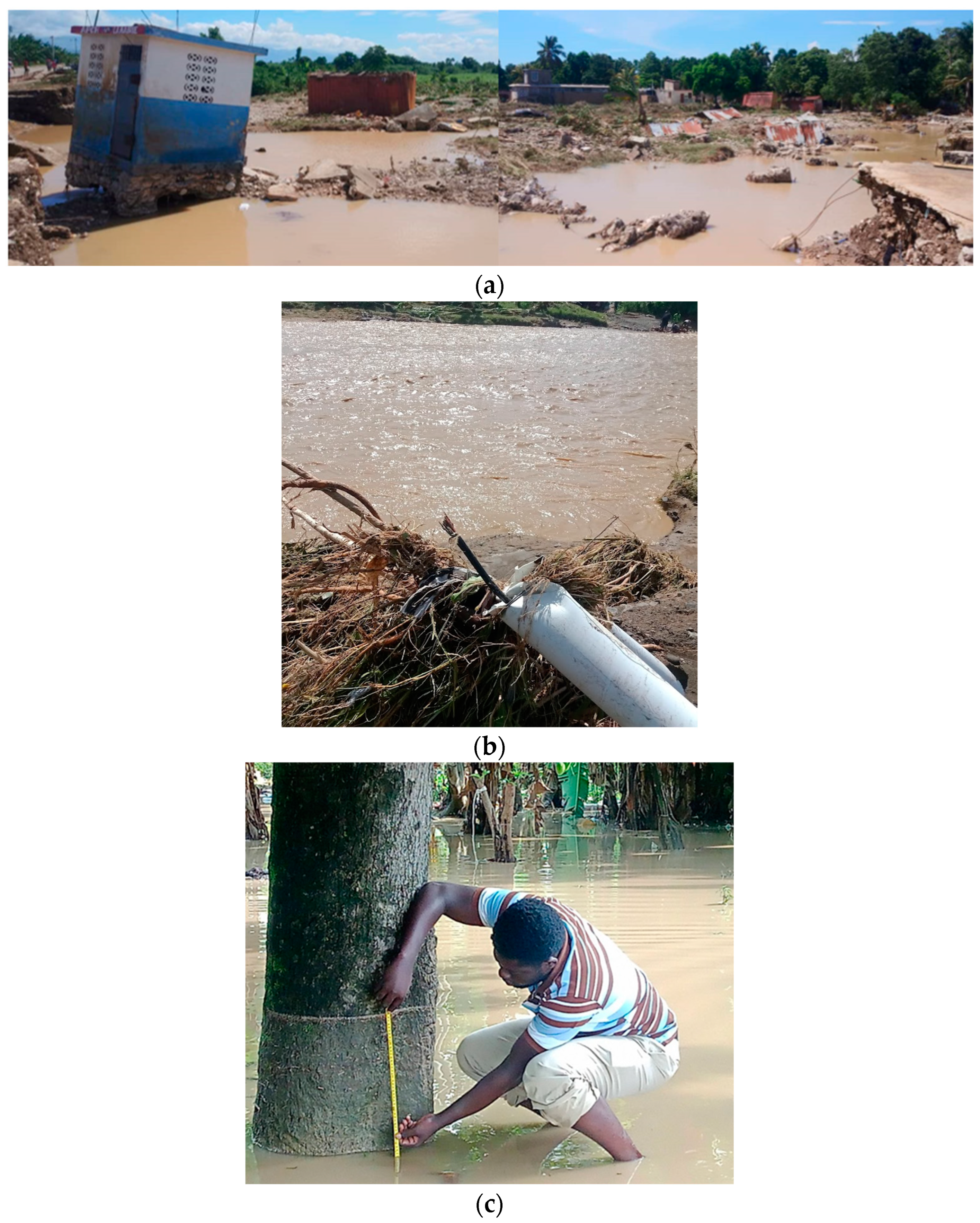

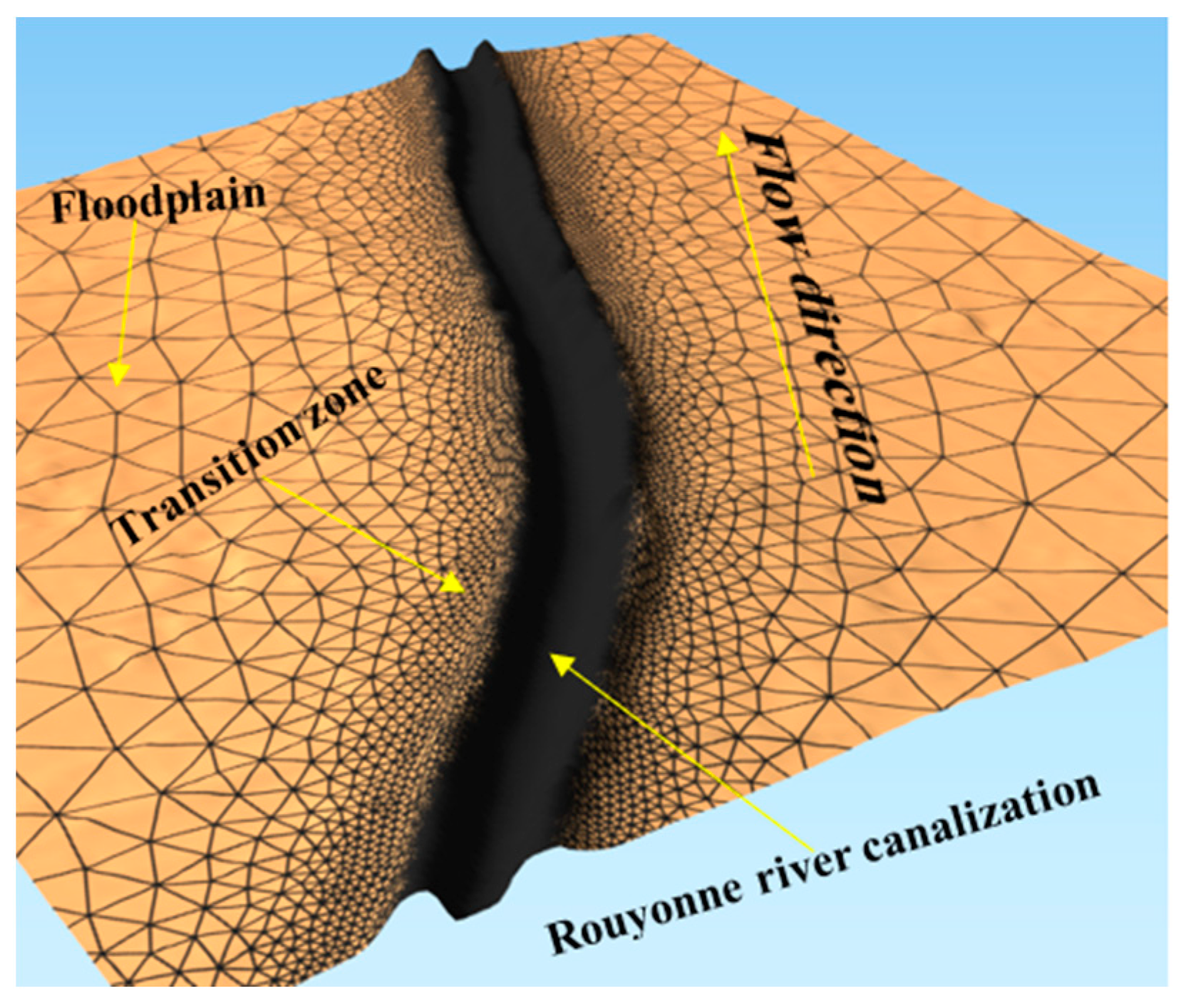
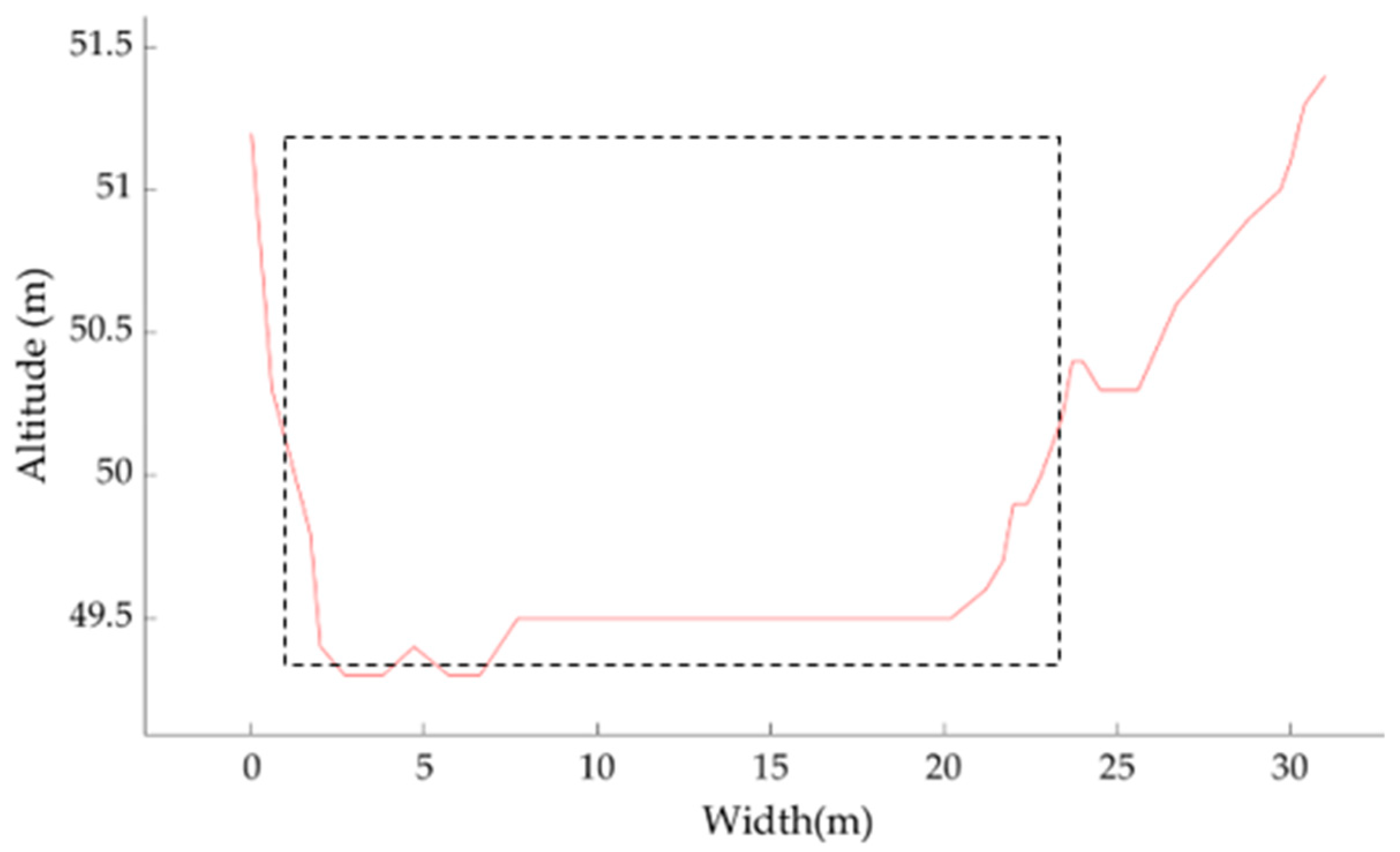
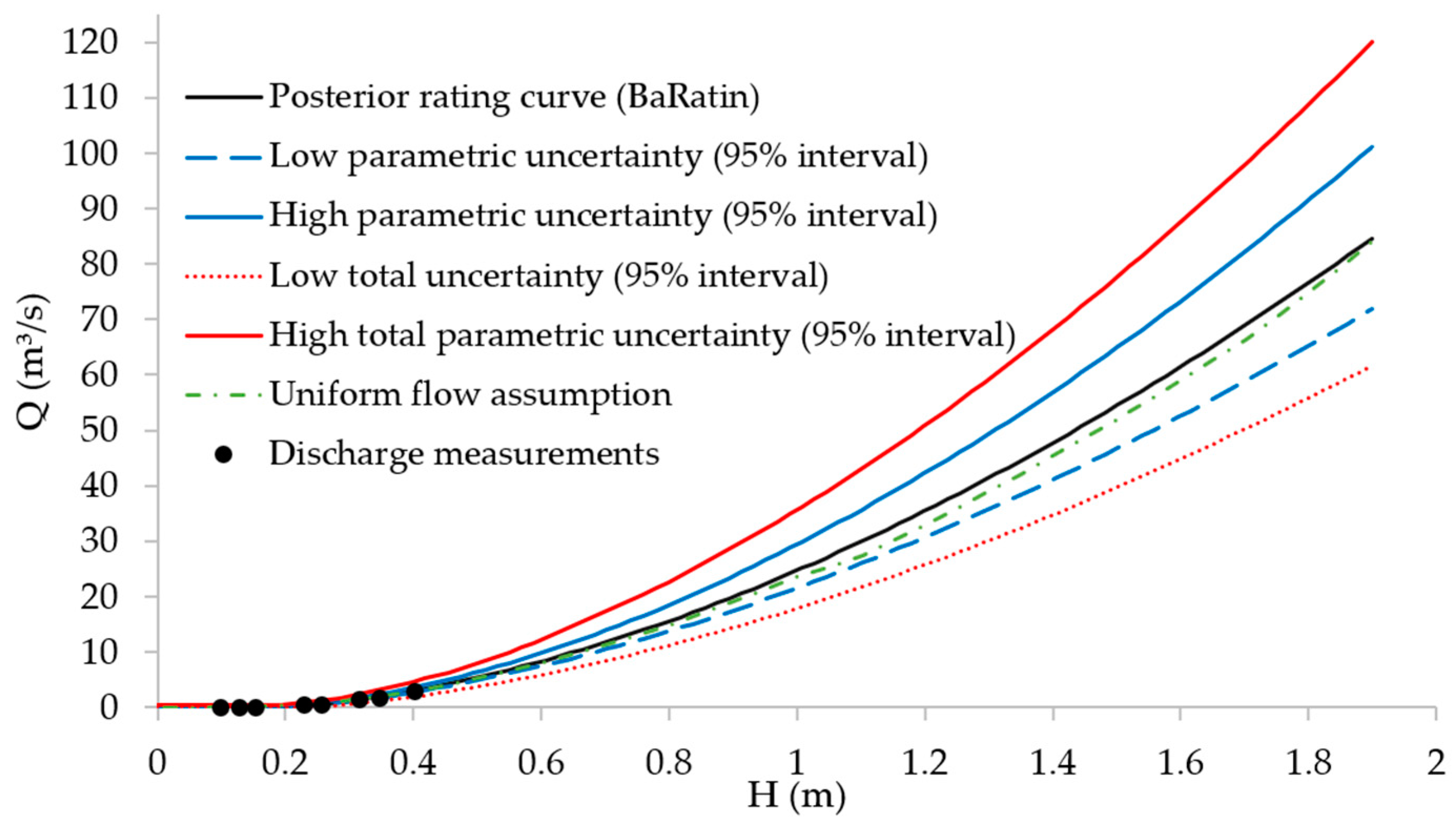


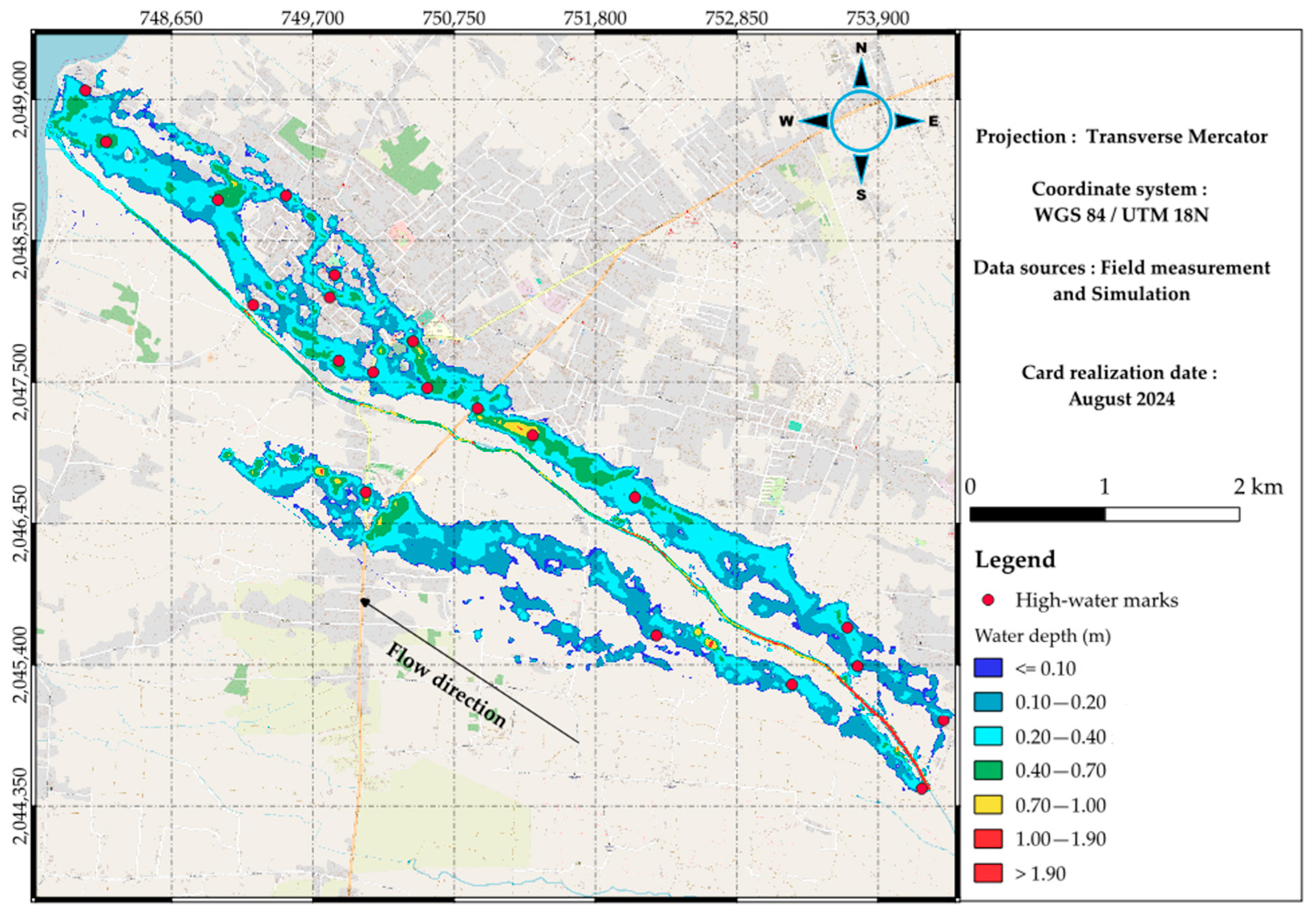
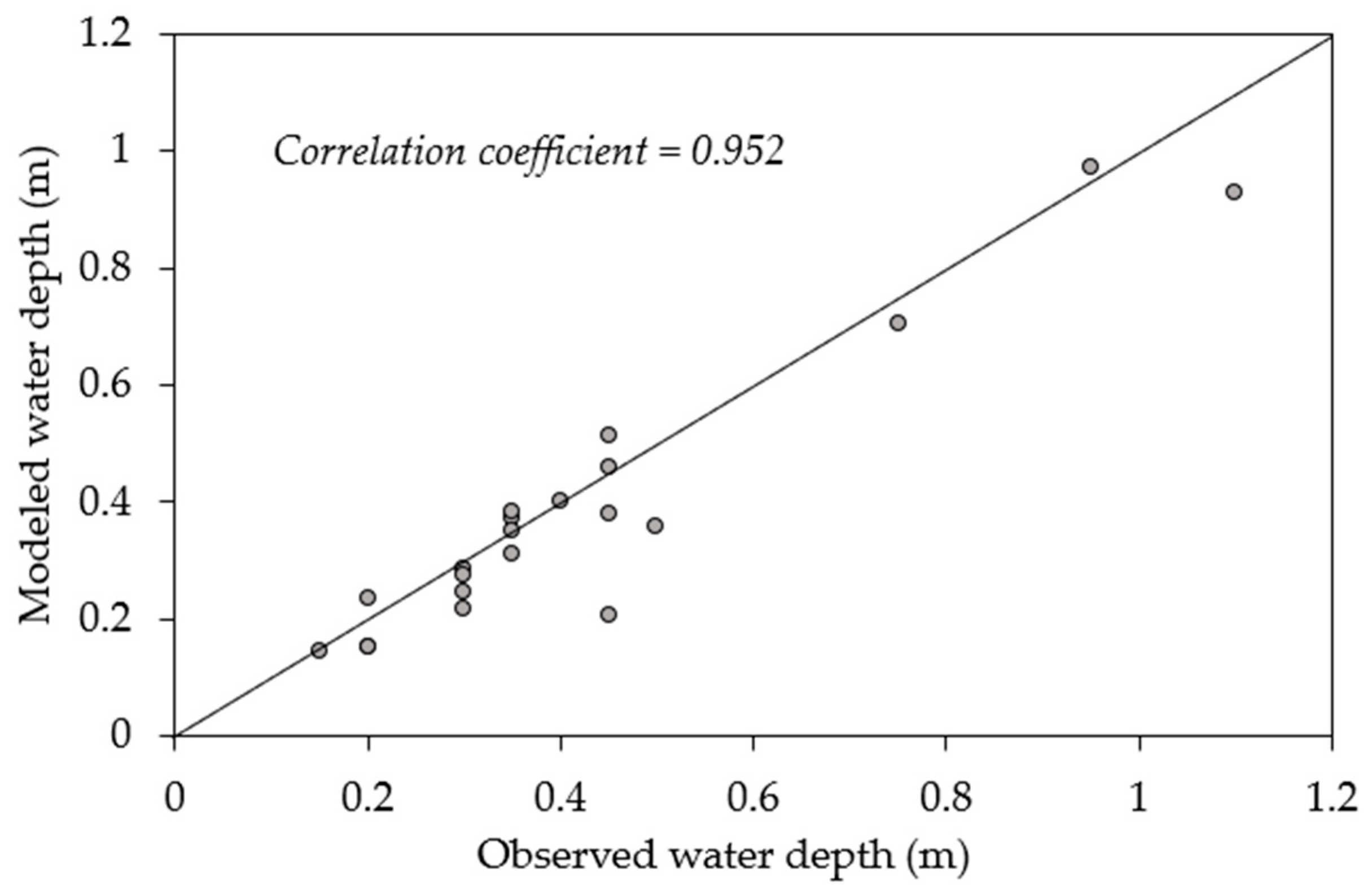

| Data | Sources | Resolution | Explanations |
|---|---|---|---|
| Terrain data | DTM of CNIGS | 1.5 m | Official data based on a LiDAR survey in 2014–2016 by IGN FI. |
| Drone photogrammetry | 0.1 m | Data were constructed during this study to update the bathymetry of the Rouyonne River. | |
| Rainfall data | 3 rain gauges | 1 min | Calibration of the hydrological model (21–22 August 2022), validation (20 September 2022), and application to the flood event (2–3 June 2023). |
| Hydrometric data | OTT PLS pressure sensor; | 1 min | Three sets of water-level data for the same dates at the measuring station. |
| magnetic induction current meter “MF Pro” | Maximum water depth sampled for construction of the water depth–discharge relationship: 0.40 m. | ||
| Inundation data | Field measurement | 21 water-level measurement points were collected (24 h after the 2–3 June 2023 event) from high-water marks. |
| Calibrated Parameters | ||||
|---|---|---|---|---|
| S = 82.44 mm | V0 = 5.43 m/s | ds = 1 | ω = 0.02 | K0 = 0.73 |
| Statistical scores: calibration | ||||
| KGE = 0.923 | ||||
| NSE = 0.878 | ||||
| Statistical scores: validation | ||||
| KGE = 0.906 | ||||
| NSE = 0.925 | ||||
Disclaimer/Publisher’s Note: The statements, opinions and data contained in all publications are solely those of the individual author(s) and contributor(s) and not of MDPI and/or the editor(s). MDPI and/or the editor(s) disclaim responsibility for any injury to people or property resulting from any ideas, methods, instructions or products referred to in the content. |
© 2024 by the authors. Licensee MDPI, Basel, Switzerland. This article is an open access article distributed under the terms and conditions of the Creative Commons Attribution (CC BY) license (https://creativecommons.org/licenses/by/4.0/).
Share and Cite
Louis, R.; Zech, Y.; Joseph, A.; Gonomy, N.; Soares-Frazao, S. Flood Modeling of the June 2023 Flooding of Léogâne City by the Overflow of the Rouyonne River in Haiti. Water 2024, 16, 2594. https://doi.org/10.3390/w16182594
Louis R, Zech Y, Joseph A, Gonomy N, Soares-Frazao S. Flood Modeling of the June 2023 Flooding of Léogâne City by the Overflow of the Rouyonne River in Haiti. Water. 2024; 16(18):2594. https://doi.org/10.3390/w16182594
Chicago/Turabian StyleLouis, Rotchild, Yves Zech, Adermus Joseph, Nyankona Gonomy, and Sandra Soares-Frazao. 2024. "Flood Modeling of the June 2023 Flooding of Léogâne City by the Overflow of the Rouyonne River in Haiti" Water 16, no. 18: 2594. https://doi.org/10.3390/w16182594
APA StyleLouis, R., Zech, Y., Joseph, A., Gonomy, N., & Soares-Frazao, S. (2024). Flood Modeling of the June 2023 Flooding of Léogâne City by the Overflow of the Rouyonne River in Haiti. Water, 16(18), 2594. https://doi.org/10.3390/w16182594








